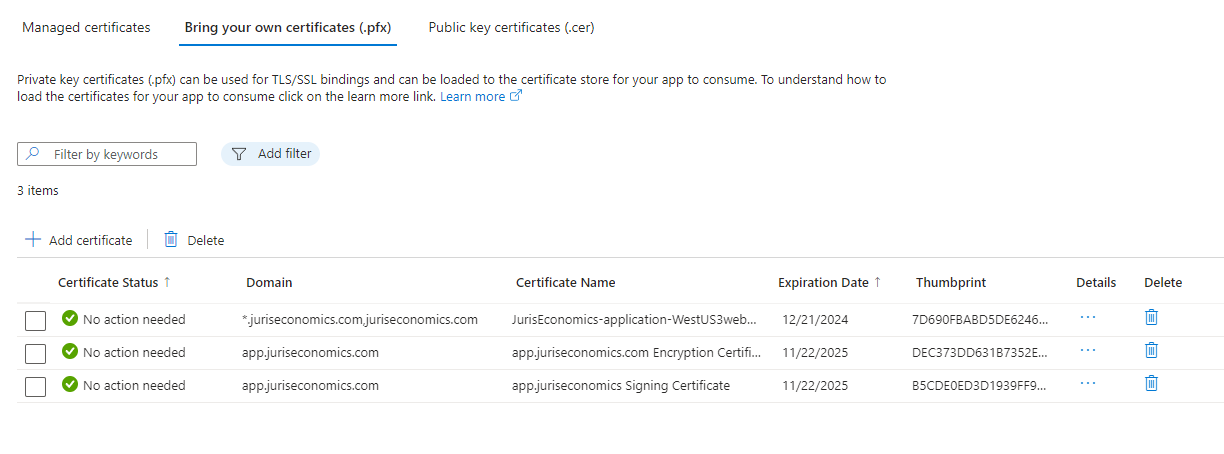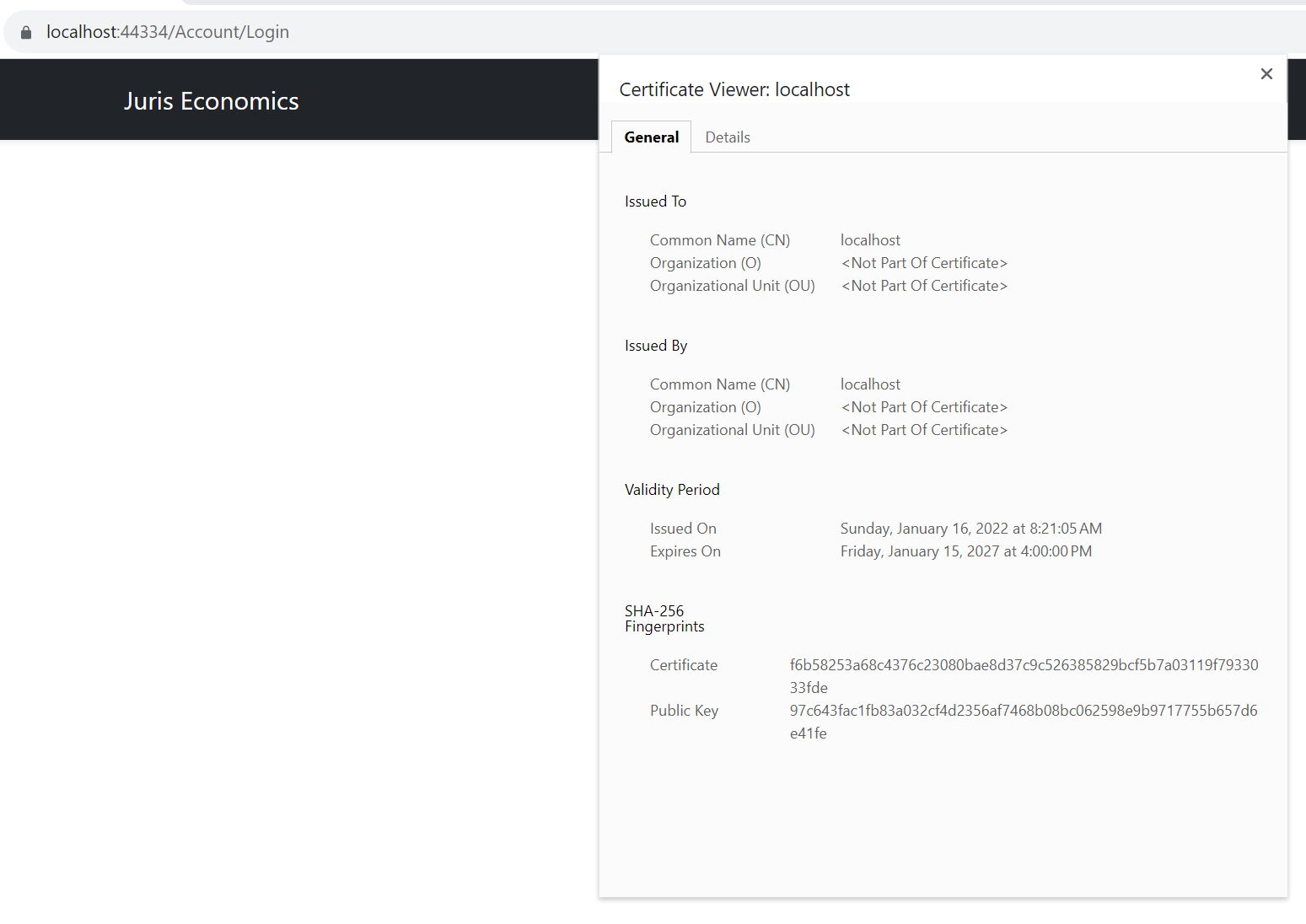Activities of "treggon@gmail.com"
You are confusing HTTP certificate and Signing&Encryption certificate (https://documentation.openiddict.com/configuration/encryption-and-signing-credentials.html)
Also see: https://docs.abp.io/en/abp/latest/Deployment/Configuring-OpenIddict
I would think that with all the context I provided I would have got something better than, you are confused. We are currently also evaluating another year of license or to switch. This is our first question this year.
You are confusing HTTP certificate and Signing&Encryption certificate (https://documentation.openiddict.com/configuration/encryption-and-signing-credentials.html)
Also see: https://docs.abp.io/en/abp/latest/Deployment/Configuring-OpenIddict
I am not confused, I am just pointing out the different certs I am using and wondering how to fix this.
On Azure, certificates can be uploaded and exposed to Azure App Service applications using the special WEBSITE_LOAD_CERTIFICATES flag. For more information, visit Use a TLS/SSL certificate in your code in Azure App Service.
Where I got the code to load the cert.
Where I got the code to load the cert.
Its got the super useful error code of 0x00 The rest of the site works with the application certificate but those don't have a thumbprint, this is just with OpenID certs Signing and Encryption.
I pulled this from the Application log. This is what is shown in the logs when I load that page. Seems like its just not loading the cert using the thumbprint, but I don't understand.
`2023-11-28T17:57:00 Welcome, you are now connected to log-streaming service. The default timeout is 2 hours. Change the timeout with the App Setting SCM_LOGSTREAM_TIMEOUT (in seconds).
HTTP Error 500.0 - Internal Server Error
The page cannot be displayed because an internal server error has occurred.
- ABP Framework version: v7.3.3
- UI Type: Blazor Server
- Database System:SQL Server on Azure
- Tiered (for MVC) or Auth Server Separated (for Angular): no
- Exception message and full stack trace: This page isn’t working
- Steps to reproduce the issue: Publish an app to Azure App Service and try to login using OpenID
Example.... https://app.juriseconomics.com/Account/Login is not working as the certificate is not loading correctly.
I have been following the OpenID information that I found on their website directly: https://documentation.openiddict.com/configuration/encryption-and-signing-credentials.html#registering-a-certificate-recommended-for-production-ready-scenarios and have followed some of the tutorials https://brianmeeker.me/2022/08/29/setting-up-abp-with-openiddict-on-azure-app-services/
And I had it working for a long time, but something I am doing is now wrong. It works fine locally with the development certificates on localhost, but when I publish, anything that requires the MultiTenancy basically will fail, so I have a fallback page. Here is a screenshot of the comma delaminated list of certs to load in configuration.

 `if (hostingEnvironment.IsProduction())
{
PreConfigure
`if (hostingEnvironment.IsProduction())
{
PreConfigure
});
PreConfigure<OpenIddictServerBuilder>(builder =>
{
// Load from Thumprint
var SigningCert = GetSigningCertificate(hostingEnvironment, configuration, configuration["AuthServer:SigningCertificateThumbprint"]);
var EncryptionCert = GetEncryptionCertificate(hostingEnvironment, configuration, configuration["AuthServer:EncryptionCertificateThumbprint"]);
builder.AddSigningCertificate(SigningCert);
builder.AddEncryptionCertificate(EncryptionCert);
// Load from files
//builder.AddSigningCertificate(LoadCertificate(configuration["AuthServer:SigningCertificateThumbprint"]));
//builder.AddEncryptionCertificate(LoadCertificate(configuration["AuthServer:EncryptionCertificateThumbprint"]));
builder.SetIssuer(new Uri(configuration["AuthServer:Authority"]));
});
}This is the code I used to generate the certs that were uploaded. public void CreateEncryptionCert()
{
using var algorithm = RSA.Create(keySizeInBits: 2048);
var subject = new X500DistinguishedName("CN=app.juriseconomics.com");
var request = new CertificateRequest(subject, algorithm, HashAlgorithmName.SHA256, RSASignaturePadding.Pkcs1);
request.CertificateExtensions.Add(new X509KeyUsageExtension(X509KeyUsageFlags.KeyEncipherment, critical: true));
var certificate = request.CreateSelfSigned(DateTimeOffset.UtcNow, DateTimeOffset.UtcNow.AddYears(2));
System.IO.File.WriteAllBytes("wwwroot/encryption-certificate.pfx", certificate.Export(X509ContentType.Pfx, "XXXX"));
}
public void CreateSigningCert()
{
using var algorithm = RSA.Create(keySizeInBits: 2048);
var subject = new X500DistinguishedName("CN=app.juriseconomics.com");
var request = new CertificateRequest(subject, algorithm, HashAlgorithmName.SHA256, RSASignaturePadding.Pkcs1);
request.CertificateExtensions.Add(new X509KeyUsageExtension(X509KeyUsageFlags.DigitalSignature, critical: true));
var certificate = request.CreateSelfSigned(DateTimeOffset.UtcNow, DateTimeOffset.UtcNow.AddYears(2));
System.IO.File.WriteAllBytes("wwwroot/signing-certificate.pfx", certificate.Export(X509ContentType.Pfx, "XXXX"));
}`
The following is code that I used to get the certs.... private X509Certificate2 GetSigningCertificate(IWebHostEnvironment hostingEnv, IConfiguration configuration, string thumbprint) {
using (X509Store certStore = new X509Store(StoreName.My, StoreLocation.CurrentUser))
{
certStore.Open(OpenFlags.ReadOnly);
string certThumbprint = thumbprint; // 7D690FBABD5DE6246422E81836D16B22CF57D49F,98CEE0FD7F6ACD62C7C81784EDE5E78F86A83F1C,400B611BC5CF693DACAB6ABACE21DD31790D4A90,2EB0F42C5107C4E8C07BD6CE4D53F853F03AADA1
bool validOnly = false;
X509Certificate2Collection certCollection = certStore.Certificates.Find(
X509FindType.FindByThumbprint,
// Replace below with your certificate's thumbprint
certThumbprint,
validOnly);
// Get the first cert with the thumbprint
X509Certificate2 cert = certCollection.OfType<X509Certificate2>().FirstOrDefault();
if (cert is null)
throw new Exception($"Certificate with thumbprint {certThumbprint} was not found");
// Use certificate
Console.WriteLine(cert.FriendlyName);
// Consider to call Dispose() on the certificate after it's being used, available in .NET 4.6 and later
return cert;
}
} private X509Certificate2 GetEncryptionCertificate(IWebHostEnvironment hostingEnv, IConfiguration configuration, string thumbprint) {
using (X509Store certStore = new X509Store(StoreName.My, StoreLocation.CurrentUser))
{
certStore.Open(OpenFlags.ReadOnly);
string certThumbprint = thumbprint; // 7D690FBABD5DE6246422E81836D16B22CF57D49F,98CEE0FD7F6ACD62C7C81784EDE5E78F86A83F1C,400B611BC5CF693DACAB6ABACE21DD31790D4A90,2EB0F42C5107C4E8C07BD6CE4D53F853F03AADA1
bool validOnly = false;
X509Certificate2Collection certCollection = certStore.Certificates.Find(
X509FindType.FindByThumbprint,
// Replace below with your certificate's thumbprint
certThumbprint,
validOnly);
// Get the first cert with the thumbprint
X509Certificate2 cert = certCollection.OfType<X509Certificate2>().FirstOrDefault();
if (cert is null)
throw new Exception($"Certificate with thumbprint {certThumbprint} was not found");
// Use certificate
Console.WriteLine(cert.FriendlyName);
// Consider to call Dispose() on the certificate after it's being used, available in .NET 4.6 and later
return cert;
}
}
HELP!



